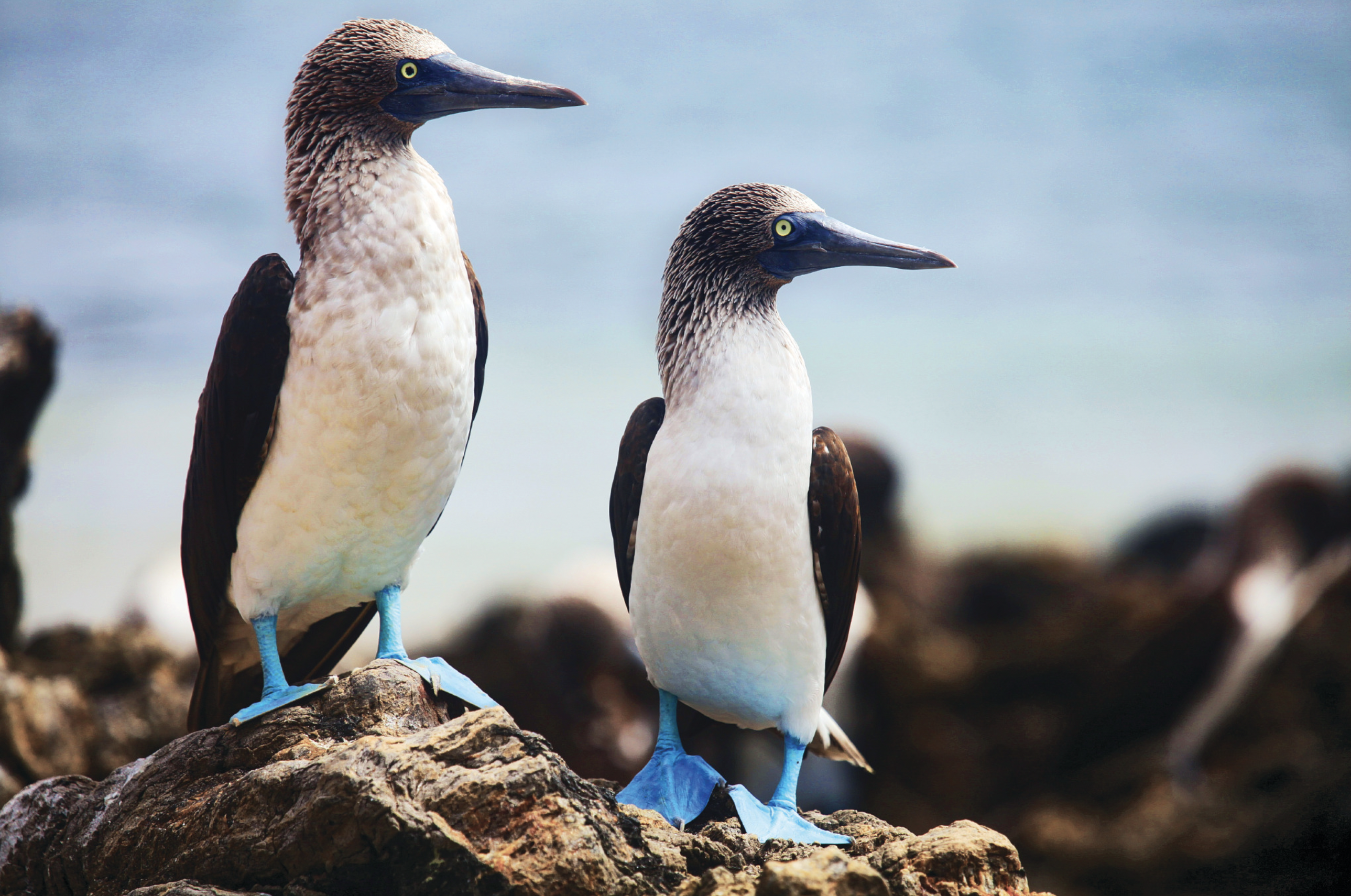On Silversea’s Silver Origin newest Galapagos vessel, Jeannine Williamson explores the magical islands that inspired Charles Darwin himself.
“Don’t worry, they are juvenile males and just want to play,” says our guide, Marco, as several sea lions spot us treading water, lumber awkwardly towards the edge of the rocks and plunge in.
Marco signals for us to follow him and as we dip our snorkel masks beneath the surface and kick our fins, we watch the sea lions – now transformed into sleek aquatic athletes – twist and dive alongside us.
On arrival in the Galapagos Islands we’d been briefed to always stay a couple of metres away from any wildlife, but clearly the most commonly seen marine mammals in the archipelago aren’t interested in abiding by any rules. Two of them almost touch us as they swim alongside. Their whiskered faces momentarily gaze curiously into ours before they dodge around an unhurried turtle floating below us and decide to head off in search of more fast-paced fun.
The underwater encounter is an exhilarating experience and it’s one of the main topics of conversation over dinner aboard Silversea’s Silver Origin a few hours later. That said, we never run out of subjects to talk about, as every day brings at least one pinch-me moment.
These protected islands scattered 600 miles off the coast of Ecuador are a unique bucket list destination, where you can witness firsthand an incredible story of evolution and natural history that’s like nowhere else on earth.
They were made famous by the renowned British naturalist Charles Darwin who arrived on the research vessel HMS Beagle in 1835 and was astonished at what he found, including iguanas swimming in the sea and giant tortoises and finches that differed from island to island.
He challenged common scientific thinking of the day with his theory that the creatures able to adapt to their environment were the ones that made it.
During our round-trip expedition cruise from San Cristobal – one of four inhabited islands in the group of more than 120 isles and islets created by volcanic eruptions over five million years – we visited places unchanged since Darwin’s day, aside from hiking trails and wooden stairs created to ease walking and access the steepest hills.
As Silver Origin is always at sea and doesn’t stop at any ports, all tours are by Zodiac; over a week there were seven landings for guided walks and a daily choice of scenic boat trips, kayaking and snorkelling.
Tourism is strictly controlled and there’s never any chance of ending up in a crowd as only one ship at a time is allowed at each destination. This makes everything even more special.
On a Zodiac sailing past craggy Vicente Roco Point we got our first sighting of the world’s only tropical penguin. Marco explains they were originally swept over from Antarctica on the Humboldt Current, which flows north from their original habitat and along the west coast of South America.
“It was a one-way ticket – they couldn’t get back, so they had to adapt if they were going to survive and they now have a much thinner plumage,” he explains, also pointing out how the birds spread their wings to keep cool and lean forwards to protect their feet from the sun.
Further along the coastline, feet come to the fore again as we spot one of the most recognisable species in the Galapagos, the almost comical looking blue-footed boobie.
Marco tells us their vividly coloured feet are due to pigments in their diet. But they are not just an adornment: during mating season, the males attract prospective suitors with an elaborate courtship dance that shows off their feet to the best advantage and females are drawn to the birds with the brightest feet.

Another extraordinary bird that is unique to the Galapagos, and only found on the islands of Isabela and Fernandina is the flightless cormorant. It is the largest of the world’s 29 species of cormorant and the only one that cannot fly.
Again, our Zodiac provided a close glimpse of the black birds with jewel-like turquoise eyes. They look ungainly as they hop from rock to rock extending their stubby little wings for balance. Again, with no natural predators they no longer need to fly, but when it comes to hunting for food it’s a different matter.
They barely make a ripple as they dive like arrows into the sea, reaching depths of up to eight metres and staying below for more than a minute at a time in search of fish.
Land hikes bring one-of-a-kind experiences at every stop. At Espinoza Point on Fernandina we have to carefully step around hundreds of inert marine iguanas basking on the beach.
The lethargic scene is occasionally broken by females digging deep nests in the sand while vivid orange Sally Lightfoot crabs busy themselves alone the shoreline. Another day we see land iguanas with shimmering golden scales.
Other curiosities include the small lava lizards that can be found across most of the archipelago, with some species endemic to individual islands. It’s believed they arrived from the mainland on floating rafts of vegetation carried by ocean currents.
It’s fascinating to watch them communicate with each other using a series of vigorous push-ups and head bobs.
The big daddy of all wildlife is the giant Galapagos tortoise, which we see on a visit to Santa Cruz, another of the populated islands.
These tortoises are found nowhere else in the world. In fact, the name of the islands derives from the saddle-back shape of the shell that reminded the 16th century colonising Spaniards of the shape of a horse riding saddle known as a galapago.
The tortoises were almost hunted to extinction by 18th and 19th century sailors who kept them onboard ships as a fresh food source due their ability to survive for months at a time without food or water.
Nowadays, of course, the reptiles, like all species in the Galapagos, are safeguarded and no longer have any fear of humans which means you can get up close and get amazing photos.
We see them on a visit to Montemar, an eco-reserve where the tortoises roam freely and bathe in mud pools to keep cool. Montemar also has an organic coffee plantation and afterwards there’s an entertaining and informative coffee and chocolate tasting and the chance to buy jewellery and products made by local craftspeople. Many are made from recycled materials, including novel rings created from old skateboards.
Omnipresent wildlife aside, there are some fascinating man-made sights, too. On Floreana we land on the wide sheltered sweep of Post Office Bay and walk a short distance along the sand to find the story behind its name.
Up a short pathway is a wooden barrel, recreating the one first created by homesick whalers from the UK and America when they stopped at the island to replenish water supplies.
They posted letters to their families that were delivered by mariners who were heading back to their home ports. Today’s visitors can pop their own cards in the stampless mailbox and hope they are picked up by subsequent passers-by from their countries.
It’s a fun thing to do and one of mine arrived on a friend’s doormat – stamped by the sender – a month afterwards.

We travelled in ultimate comfort on Silversea’s first-ever destination specific ship, launched earlier this year.
Silver Origin replacing Silver Galapagos. It’s is a third larger, but carries the same number of passengers – just 100. The ship incorporates eco-friendly technology as part of the line’s commitment to the environment.
An innovative area is Basecamp, the hub for meeting for shore tours, chatting to members of the expedition team and changing out of snorkelling gear. The area has an interactive LED screen with facts and stunning video footage on the islands.
It’s the only ship in the Galapagos to feature butler service to every suite. As it sails year-round there are novel amenities such as a cosy faux fire pit where guests can gather on chillier evenings.
There’s also a stargazing platform to observe the unpolluted night skies.
Half of the food served onboard comes from the islands, including meat, cheese and home-made guava jam from small farms and artisan producers. The rest comes from the Ecuadorian mainland.
Many passengers – myself included – were surprised to discover Ecuador produces wine from a range of grape varieties. It was among the wines offered at mealtimes and really worth a try.
One day, executive chef Carlo Bermudez shared the secrets of creating the perfect ceviche. The South American staple made by marinating raw fish and other ingredients in lime juice. Like the rest of the food on board, it was fresh and delicious.
The two dining venues are The Restaurant and The Grill, both large enough to seat all passengers at the same time. The Grill, on the top deck, converts from al fresco to indoor dining depending on the weather. It also features Silversea’s Hot Rocks dining concept where you cook meat and seafood on sizzling heated stones.
The cabins are well designed, again with the destination in mind. There’s walk-in space in the wardrobe to store expedition equipment. New to Silversea are so-called horizon balconies. With drop-down floor-to-ceiling panoramic windows and a tiled floor area with a table and seating they form part of the main cabin area. Or, they can be turned into an ‘indoor’ veranda that can be sectioned off from the rest of the suite.
Another innovative addition is a sliding mirror in the bathroom that reveals a window. Youcan look out at passing views when you’re brushing your teeth.
As we disembarked Silver Origin we were met by the sight of rotund sea lions sleeping contentedly on public benches. I wondered if they were taking a rest after embarking on their energetic diving sessions with far less adept Homo sapiens.
TL;DR about cruising the Galapagos with Silversea
Highs: Exceptional and unique wildlife spotting opportunities with very knowledgeable guides, fully inclusive cruise on an eco-friendly ship with high levels of comfort and butler service in every suite.
Lowx: Due to the expedition nature of the voyage and small size of the vessel do not expect the full Silversea experience with Champagne, caviar and entertainment.
Best suited to: Outdoor types with a reasonable amount of fitness and mobility to go on hikes and get in and out of the Zodiacs used for all shore excursions.
About the Silver Origin
CRUISE LINE: Silversea
PASSENGER CAPACITY: 100
TOTAL CREW: 90
PASSENGER DECKS: 6
ENTERED SERVICE: 2022
LENGTH: 101m
FACILITIES: 51 outside cabins with ensuite facilities, two restaurants, two lounge bars, basecamp expedition area, spa, gym, sun deck with whirlpool and fire pit.
BOOKINGS: Silver Origin sails two alternating seven-night cruises in the Galapagos. All-inclusive door-to-door fares start from $16,800 and pre- and post-cruise extensions are available. Port-to-port fares, excluding flights and other travel arrangements, start from $10,450. Visit silversea.com








